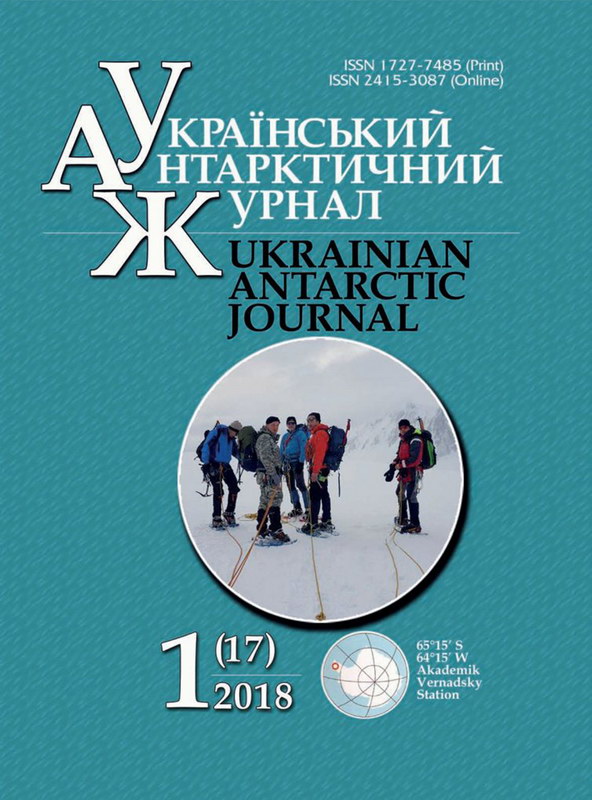Features of Seismicity in the Argentine Islands Archipelago Region Due to the Processes of Icebergs Formation
- seismicity,
- polarization,
- iceberg,
- glacier,
- destruction
- climate,
- iceberg formation ...More

This work is licensed under a Creative Commons Attribution-NonCommercial-NoDerivatives 4.0 International License.
Abstract
During the year in the region of the location of the Ukrainian Antarctic Akademik Vernadsky station large numbers of local and regional seismic signals are registered. The main objective of the study is to determine the sources of generation of seismic signals and the dynamics of seismicity in the Antarctic station area. Polarization methods used to determine the direction of the signal source are obtained using the three-component digital seismic station Guralp. The algorithm of automatic detection of seismic signals and the determination of their parameters is proposed in this work. The result of the works is the azimuthal time distribution of registered signals and the establishment of sources of their generation. It is concluded that the main sources of seismic signals around the Ukrainian Antarctic Akademik Vernadsky station are the cracking of the nearest glaciers of the archipelago, avalanches, the processes of iceberg formation processes at the nearest to the station glaciers of the Antarctic Peninsula. The largest number of signals was obtained from the processes of iceberg formation, which may be related to climate change and the environment. A further continuation of the work should be an analysis of changes in the seismicity of the region over the past decades with the involvement of seismic data from neighboring Antarctic stations, determining the connection of seismicity with climate change. The greatest interest in observing the variations in the rate of destruction of glaciers in the polar regions can be to assess the impact of short and medium-term climate change on the environment. Seismic observations are a relatively cheap, year-round and all-weather instrument for solving the problem of observing glaciers, and phenomena associated with them.
References
- Liashchuk, O. I., Shapka, V. N., Gordienko, Yu. O., Karagin, Ye. V. 2006. Otsenka chuvstvitel'nosti seysmicheskoy stantsii AIA po rezul'tatam registratsii signalov ot seysmicheskikh istochnikov [Assessment of the sensitivity of the AIA seismic station based on the results of recording signals from seismic sources]. Ukrainskij Antarktychnij Zhurnal [Ukrainian Antarctic Journal], 4-5, 203-206.
- Liashchuk, O. I. 2014. Mozhlyvist′ poperedzhennya pro zahrozu tsunami vnaslidok zemletrusiv u mori Skosha za dopomohoyu heofizychnykh metodiv [Possibility of warning of tsunami threat due to earthquakes in the sea of Skosha using geophysical methods]. Ukrainskij Antarktychnij Zhurnal [Ukrainian Antarctic Journal], 13, 61-66.
- Liashchuk, O. I., Andrushchenko Yu. A. Karagin Ye.V . 2015. Osoblyvosti vykorystannya seysmichnoho shumu dlya vyvchennya hlybynnoyi budovy Zakhidnoyi Antarktyky [Features of the use of seismic noise to study the depth of the structure of Western Antarctica]. Ukrainskij Antarktychnij Zhurnal [Ukrainian Antarctic Journal], 14, 58-65.
- Fedorov, A. V. Asming, V. E., Baranov, S. V., Vinogradov, A. N., Yevtyugina, Z. A., Goryunov V. A. 2016. Seysmologicheskiye nablyudeniya za aktivnost'yu lednikov arkhipelaga Shpitsbergen [Seismological observations of the activity of the glaciers of the Svalbard archipelago]. Vestnik MGTUb. [Bulletin of MGTU], 19b, 1/1. 151-159. https://doi.org/10.21443/1560-9278-2016-1/1-151-159
- Bataille, K. and Chiu, J. M., 1991, Polarization analysis of high-frequency, three-component seismic data: Bull. Seis. Soc. Am., 81, 622-642.
- Flinn, E. A., 1965. Signal analysis using rectilinearity and direction of particle motion. Proc. I.E.E.E., 53, 1874-1876. https://doi.org/10.1109/PROC.1965.4462
- Kohler, A., Chapuis, A., Nuth C., Kohler J., Weidle C. 2012. Autonomous detection of calving-related seismicity at Kronebreen, Svalbard. The Cryosphere, 6, 393-406, https://doi.org/10.5194/tc-6-393-2012
- Neave, K. G., Savage J. C. 1970. Icequakes on Athabasca Glacier. J. Geophys. Res. 75, 1351-1362. https://doi.org/10.1029/JB075i008p01351
- O'Neel, S., Marshall, H.-P., Mcnamara, D., Pfeffer, W. 2007. Seismic detection and analysis of icequakes at Columbia Glacier, Alaska. J. Geophys. Res. 112. F03S23. https://doi.org/10.1029/2006JF000595
- Podolskiy, E. A., Sugiyama, S., Funk, M., Walter, F., Genco, R., Tsutaki, S., Minowa, M., and Ripepe, M. 2016. Tide-modulated ice flow variations drive seismicity near the calving front of Bowdoin Glacier, Greenland. Geophys. Res. Lett., 43, 2036-2044, https://doi.org/10.1002/2016GL067743
- Podolskiy, E.A., Walter, F. 2016. Cryoseismology, Rev. Geophys., 54, 708-758, https://doi.org/10.1002/2016RG000526
- Stephen A. Veitch, 2016. Glacial Earthquakes and Glacier Seismicity in Greenland. Columbia University Academic Commons, https://doi.org/10.7916/D8J1035T.
- Trnkoczy, A. 2009. Understanding and parameter setting of STA/LTA trigger algorithm. In: Bormann, P. (Ed.), New Manual of Seismological Observatory Practice (NMSOP), Potsdam:Deutsches Geo Forschungs Zentrum GFZ, 1-20. DOI: http://doi.org/10.2312/GFZ.NMSOP_r1_IS_8.1.
- Vanwormer, D., Berg, E. 1973. Seismic evidence for glacier motion. J. Glaciol., 12, 259-265. https://doi.org/10.1017/S002214300003207X
- Weaver, C. S., Malone S. D. 1979. Seismic evidence for discrete glacier motion at the rock - ice interface. J. Glaciol., 23, 89. https://doi.org/10.3189/S0022143000029816
- Withers, M., Aster, R., Young, C., Beiriger, J., Harris, M., Moore, S. and Trujillo, J. 1998. A Comparison of Select Trigger Algorithms for Automated Global Seismic Phase and Event Detection. Bulletin of the Seismological Society of America, 88, 1, 95-106.

